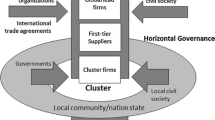Abstract
Political changes in Eastern Europe will help to cement improving economic relations between those countries and the EC, accelerating a trend that flows in part from the continuing economic difficulties in Eastern Europe. Hungary has little alternative but to seek to continue strengthening these ties. Membership in the EC could lead to an expansion of Hungarian exports to the Communities of some 48 percent, with the main gains occurring for meats, iron and steel, fruit and vegetables, textiles, and clothing. Even if membership is unattainable, Hungary stands to gain considerably from an improvement in its standing in the EC pyramid of privileges, and must seek some closer relationship with the EC, encompassing agriculture as well as manufactures, and tariffs and non-tariff barriers.
Similar content being viewed by others
References
Center for Business Strategy (1989)1992:Myths and Realities. London: London Business School.
Commission of the European Communities (1987) “The Single Act: A New Frontier, Programme of the Commission for 1987”,Bulletin of the European Communities, supplement 1/87.
Economist Intelligence Unit, different issues.
Hine, R. (1985)The Political Economy of European Trade. Brighton: Wheatsheaf.
Hungarian Scientific Council for World Economy (1989) “The Single European Market 1992: Chances and Tasks for Hungary,”Trends in World Economy 62, Budapest.
Le Club de Bruxelles (1987)Le project de marché unique européen. Brussels: European News Agency.
Kostrzewa, W. and H. Schmieding (1989) “EFTA Option for the Reform States of Eastern Europe”,The World Economy 12, 501–514.
Laird, Sam and Alexander Yeats (1990a)Quantitative Methods for Trade Barrier Analysis. MacMillan: London.
Laird, Sam and Alexander Yeats (1990b) “Two Sources of Bias in Standard Partial Equilibrium Trade Models,” PRE WPS No. 374, Washington, D.C.: The World Bank.
Marrese, M. (1988) “Understanding Hungary's Multiple Trade Attachments to the Soviet Union, the Rest of the CMEA, and the West,” unpublisherd paper, February.
Messerlin, Patrick (1988) “Anti-dumping Laws and Developing Countries,” PPR WPS 16, Washington D.C.: The World Bank.
Narjes, K. H. (1984) “Internal Market Problems of the European Community,”The World Economy 7, 215–217.
O'Cleireacain, S. (1990) “Europe 1992 and Gaps in the EC's Common Commercial Policy,”Journal of Common Market Studies 282, 201–217.
Pelkmans, J. (1986)Completing the Internal market for Industrial Products Luxembourg: Commission of the European Communities.
Pelkmans J. and A. Winters (1988) “Europe's Domestic Market,” Royal Institute of International Affairs, Chatham House Papers, No. 43, London.
Robson, P. and J. Pelkmans (eds) (1987) Special Issue: “Making the Common Market Work”,Journal of Common Market Studies 25, No. 3, March.
Sapir, A. (1988) “Does 1992 Come Before or After 1990? On Regional versus Multilateral Integration,” in Jones, R. and Krueger, A. (1990),The Political Economy of International Trade, Cambridge, Mass.: Basil Blackwell, 197–222.
Stankovsky, J. (1988)Single Market in Europe and Prospects for East-West Relations. Austrian Institute of Economic Research, No. 39.
Tomann, H. (1989) “EC Internal Market: An Opportunity for CMEA Countries?”Intereconomics 24, 303–308.
Tovias, A. (1991) “EC-Eastern Europe: A Case Study of Hungary,”Journal of Common Market Studies 34, 291–315.
Van Den Bossche, A. M. (1989) “GATT: The Indispensable Link Between the EEC and Hungary?”Journal of World Trade 23, 141–55.
Author information
Authors and Affiliations
Rights and permissions
About this article
Cite this article
Tovias, A., Laird, S. Hungary's export prospects in the EC market. Open Econ Rev 3, 181–202 (1992). https://doi.org/10.1007/BF01886203
Issue Date:
DOI: https://doi.org/10.1007/BF01886203




